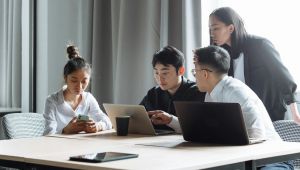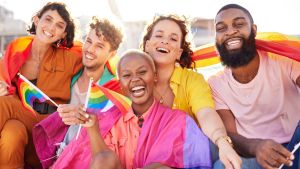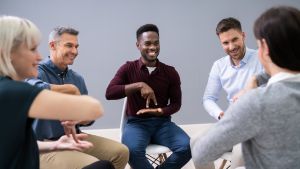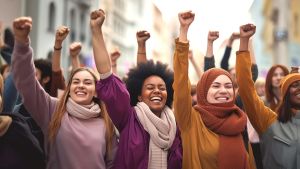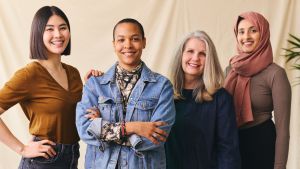There are a number of health disparities in the United States that affect underserved communities at a higher rate than the rest of the population.
For example, Black Americans between the ages of 18 and 29 are two times as likely as whites to die from heart disease and people between the ages of 35 and 64 are 50% more likely than whites to have high blood pressure, according to the Centers for Disease Control and Prevention (CDC).
Many factors contribute to the lack of care for people of color and low-income communities, which include a lack of insurance, healthcare access and education. While these disparities are far from being solved, some companies have found ways to advance health equity in underserved communities through partnerships.
Access to COVID-19 Vaccines
In 2021, the Biden Administration expressed the hope of getting to a point where 75% of the U.S. population was vaccinated against the virus to reach “herd immunity.” Research shows that roughly 69% of the country’s population is fully vaccinated, so that goal remains unmet.
Some believe we haven’t reached herd immunity yet because there are too many people who are against getting vaccinated against COVID-19. But research from the John Hopkins Center for Communications Programs shows this isn’t necessarily true and that people who are on the fence could be motivated to get vaccinated.
Aetna, a CVS Health Company (No. 28 on Fair360, formerly DiversityInc’s 2022 Top 50 Companies for Diversity list), is one organization that is working to get people from underserved communities into its retail pharmacies to get a COVID-19 vaccine.
RELATED: “Lessons Learned from COVID-19 to Advance Heath Equity Going Forward”
To get people to retail pharmacies, the company partnered with Lyft to facilitate non-medical transportation for vulnerable communities, “specifically Black and Hispanic populations,” according to DeRonn Kidd, Senior Manager, Project Program Manager for CVS Health. Kidd outlined the program during a panel titled “Health Disparities in the U.S.: Lessons from COVID & the Path Forward” at the Center for Healthcare and Innovation’s Diversity, Inclusion & Health Equity Symposium – East Coast event in New York City last month.
“That was something that was hugely successful in terms of achieving and providing access to the COVID vaccines in our retail pharmacies,” Kidd added. “The pandemic provided us with the chance to really drill down on this and achieve this in a new way that we have not done before.”
Promoting Vaccine Confidence
Aetna/CVS acknowledged hesitancy in getting the vaccine within communities of color and found ways to reach those communities and build confidence around getting COVID vaccines, which was successful because of partnerships the company formed with community organizations.
“One of the reasons why it was hugely successful was because we were really able to tap into some of the nonprofit organizations, faith-based organizations and health and wellness organizations within these communities,” Kidd said. “Be that the YMCA, be that organizations that we know our members and our patients are regularly involved with. We knew that we could trust them to reach those individuals, to build that confidence and more importantly to also help drive forward our ability to reach these vulnerable communities in the best possible way.”
To encourage people of color to get a COVID-19 vaccine, Kaiser Permanente (a Fair360, formerly DiversityInc Hall of Fame company) also worked with faith-based organizations to create trust and promote vaccine efforts. Yvette Radford, Regional Vice President for External and Community Affairs at Kaiser Permanente, explained the program for an article in Fair360, formerly DiversityInc’s “Meeting in a Box: The Importance of Community Partnerships.”
The company partnered with the Conference of National Black Churches (CNBC) and provided it with the tools and resources to “educate, mobilize and encourage vaccination efforts and increase trust,” Radford said.
“There was so much distrust out there, especially among communities of color, so working with faith-based organizations to provide them with tools and resources so that they can communicate information to their parishioners and the broader community was a partnership that we’re really proud of. It has been effective and could go beyond the pandemic in terms of using faith-based organizations to deliver important health messages,” she said.
Through a partnership that started in 2021, Abbott (No. 3 on Fair360, formerly DiversityInc’s 2022 Top 50 Companies for Diversity list) and the University of Minnesota Community University Health Care Center worked together to form a mobile clinic of healthcare workers from the community who went out and gave people COVID tests and vaccinations.
Kathryn McKenzie, Divisional Vice President, Global Citizenship and Sustainability at Abbott, said the mobile clinic has helped build trust within the community and has led to people coming into clinics for “screening and care for diseases like hypertension and diabetes as well as other needed health and social services.”
She gave an example of how care coordination was created for over 150 Afghan refugees “alongside continued health outreach and connection to additional clinic offerings like pro-bono legal or mental health support in local communities seeing significant health disparities.”
“Our goal this year is to provide targeted care for 1,800 people by staff who understand the needs and cultures of the people they serve,” McKenzie added.
Meeting People Where They Are
One of the best ways to advance health equity is by meeting people where they are, said Paul Bousquet, who heads up oncology partnerships at pharmaceutical company Roche at the healthcare event in New York City. He mentioned four places where companies can do this: the bodega, the barbershop, the bishop and the beauty salon.
RELATED: “Creating a Fair Workplace While Prioritizing Health Equity”
Meeting people in these common places within their community, and forming partnerships with those organizations and places, is a way to meet future patients.
“You are building trust for those patients but you’re also building trust for your employees,” Bousquet said. “You’re not in the ivory tower anymore. You’re in the places where patients are being affected the most. That really creates a culture of belonging.”
Abbott recognizes the importance of good health and that barriers exist for people getting the care they need.
“Poverty is at the center of many of these challenges, but there’s many other interconnected social issues like racism and access to food, healthcare, transportation and technology as well,” McKenzie said. “These gaps exist everywhere, in our own backyard, in cities and rural areas across the U.S., and in the 160-plus countries where we have a presence.”
To overcome these barriers, the company made it a priority to innovate greater access to health equity across the company and in its partnership with others.
“This work focuses on three areas: creating new health tech solutions, advancing diversity in healthcare and removing barriers to good health in communities,” McKenzie said. “And to deliver results, we’ve laid out long-term targets for our business and made health equity a key principle for our community partnerships. Our efforts to expand access to health are global in scope, with focused efforts in communities where we have a presence.”
Helping Vulnerable Populations Navigate the Healthcare System
Emory Alzheimer’s Disease Research Center has made it its mission to recruit Black Americans into its research studies, Dr. Monica Parker, Assistant Professor of Medicine in the Department of Neurology, said at the Center for Healthcare and Innovation’s healthcare event.
When looking at its research pool, Dr. Parker said Emory has learned that Black participants aren’t coming to the studies from Emory. They are coming from within the wider community.
“Why are they coming from the wider community? Because we partner with 26 different organizations that operate in the African American community, and one of the things that we need in these communities is education and information,” she said.
She added that it is important to help Black patients navigate the healthcare system so that they can get the care that they need. When a person is unable to participate in a research study because they have hypertension or another issue that prevents them from being in the study, Emory connects them with a healthcare provider to manage their health, even if that provider isn’t through Emory.
“If you want to engage people of color regardless of what their stripe is, you have to be able to address what their need is first, and I’m not even talking about compensation,” she said. “But for a population that’s aging, healthcare access is a big deal, and whether you’re Black, white or purple, if you’re an older person, you need a doctor who is sensitive to geriatric care issues.”
To help people in historically marginalized communities fight chronic diseases, Abbott launched its Future Well Communities program, which addresses social and health challenges people face daily.
Future Well Communities was implemented in Stockton, California, where nearly 60% of the population is living with prediabetes or diabetes, and the city is known as the most diverse city in America. The program is also now offered in Chicago and Waukegan, Illinois.
“You’re seeing a broad array of health barriers across a diverse collection of communities, languages and cultures,” Abbott’s McKenzie said. “There are many trusted organizations doing tremendous work at the community level to address different gaps, from food insecurity to health education to transportation. But we saw a great opportunity to coordinate these efforts across organizations and communities to better address the complex, multiple issues that people often face. For example, a person with diabetes who lives in a food desert can’t get healthy food – but they’re also having trouble getting a ride to their doctor’s office and finding a health worker who understands their needs and speaks their language.”
This sort of holistic approach from Abbott is something that the company hopes will have broader health impacts than what can be achieved with traditional patient care. By accounting for social determinants of health, how they drive health outcomes and what can be done to improve the overall picture of public health through community partnerships, the company is able to set some ambitious goals.
“Our goal is to improve the health of 10,000 people facing the greatest impact of health disparities and diabetes by meeting people where they are and helping connect them to the health and social services they need,” McKenzie said.
“One example is a ‘food as medicine’ initiative we call Healthy Food Rx, which brings together a local health center, food bank and research partner. Boxes of healthy foods are prescribed to people with diabetes and delivered directly to their doorstep, alongside cooking classes, health education and follow-up care to measure their glucose levels – which is delivering encouraging results in helping them to eat healthier and better manage their diabetes.”


